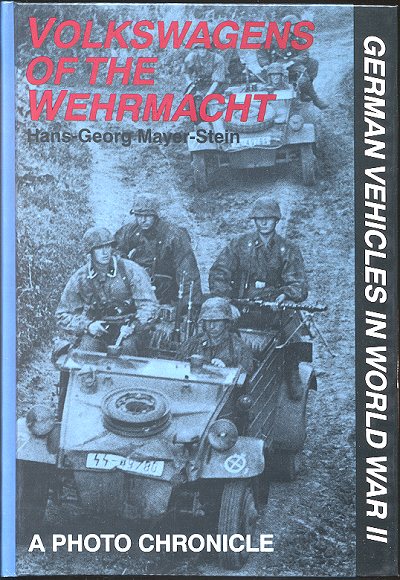 When one thinks of the
German Army during WWII, rarely does the name 'Volkswagen' come into one's mind.
Yet the precursors of the incredibly popular VW Beetle of the 50's, 60's and
70's was in use by the Wehrmacht during the war years.
When one thinks of the
German Army during WWII, rarely does the name 'Volkswagen' come into one's mind.
Yet the precursors of the incredibly popular VW Beetle of the 50's, 60's and
70's was in use by the Wehrmacht during the war years. |
BOOK: |
Volkswagens of the Wehrmacht |
|
BY: |
Hans-Georg Mayer-Stein |
|
PUBLISHER |
Schiffer, 1994 $19.95 |
|
REVIEW BY: |
|
|
NOTES: |
German Vehicles at War series |
 When one thinks of the
German Army during WWII, rarely does the name 'Volkswagen' come into one's mind.
Yet the precursors of the incredibly popular VW Beetle of the 50's, 60's and
70's was in use by the Wehrmacht during the war years.
When one thinks of the
German Army during WWII, rarely does the name 'Volkswagen' come into one's mind.
Yet the precursors of the incredibly popular VW Beetle of the 50's, 60's and
70's was in use by the Wehrmacht during the war years.
It can honestly be said that few people think of Adoph Hitler as a car enthusiast. However, it was basically because of his enthusiasm for automobiles that the Beetle (called the KdF wagen) came into being. His vision was of an inexpensive, reliable car that could be purchased by the workers in the socialist paradise that he was developing. I'll leave all the development stuff to those who wish to buy the book. Needless to say, the concept was a popular one and a number of cars were actually built and used before and during the war, albeit by the party hierarchy and not by the common worker as was planned.
Where the VW really came into its own was as a lightweight scouting vehicle, similar to the US Jeep. Though only two wheel drive, it put the power and weight where it was needed. It was also light enough not to get bogged down as easily as other vehicles. In fact, it was considered superior to motorcycles, especially in its off road abilities. This vehicle was the Kubelwagen and its amphibious cousin the schwimwagen. Both served faithfully following their introduction in the mid-war years and were highly prized. What made them so useful is that they had a lower gearing and so were able to put all 25hp to the axles. Combine this with good ground clearance and you have the perfect light scouting vehicle.
After the war, the British tested the Kubelwagen against the Jeep and the Kubelwagen outperformed it. It was enough for the British to order several thousand of these and the similarly chassied off road Beetles. This not only kept together a good work force, but also kept the factory from being destroyed by the British army. Like the French, the Brits were generally into the idea of horrendous reparations and destroying any useful industrial base the Germans may have had left. Were it not for the Marshall Plan, it is quite possible that a similar climate as after WWI would have been created in Germany.
In a similar format as the Stug book reviewed earlier, this is basically a photo book. The photographs are very good and do a superb job of showing the development and use of the various types of wartime VW. It is truly amazing how many different variants and specialty cars were developed. I was particularly intrigued by the wood gas and other alternate fuel cars that were in use, not only during, but after the war. The book does not stop with the war but continues in the post war eras up until about 1948 or so. There is also a goodly selection of later post war variations on the theme as well as surviving cars.
I ordered this book sight unseen and am very pleased with the result. For someone like myself who has no real knowledge of the subject other than having owned a later Beetle, this book was a real treat. Highly recommended.
Review copy courtesy of your wiser, but poorer editor.
If you would like your product reviewed fairly and quickly by a site that has over 1700 visits a day, please contact me or see other details in the Note to Contributors.